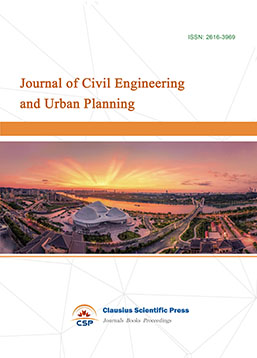Factors Influencing Carbon Emissions of Assembled Building Construction Enterprises
DOI: 10.23977/jsdgb.2023.010101 | Downloads: 59 | Views: 2997
Author(s)
Hongyu Sun 1, Qiang Liu 1, Yafeng Li 1, Ming Liu 1
Affiliation(s)
1 School of Economics and Management, Liaoning University of Technology, Jinzhou, Liaoning, 121001, China
Corresponding Author
Yafeng LiABSTRACT
In the process of national economic development, the pillar position of the construction industry is becoming more and more important, and the development of this green industry, the promotion of energy conservation and emission reduction, and the reduction of energy waste in the construction process are important development goals for the construction industry in the future period, so it is crucial for the assembly building construction enterprises to develop green buildings and optimize the construction capacity. This paper analyzes nine aspects of carbon emission influencing factors of assembly building construction enterprises in the three stages of construction decision, construction design and construction building on the basic theoretical basis, and puts forward corresponding suggestions in order to provide reference and guidance for future energy saving and emission reduction of low carbon buildings.
KEYWORDS
Assembly building, construction company, carbon emission, influencing factors, green industryCITE THIS PAPER
Hongyu Sun, Qiang Liu, Yafeng Li, Ming Liu, Factors Influencing Carbon Emissions of Assembled Building Construction Enterprises. Journal of Sustainable Development and Green Buildings (2023) Vol. 1: 1-7. DOI: http://dx.doi.org/10.23977/jsdgb.2023.010101.
REFERENCES
[1] Awbi H.B. (1992) Simulation of solar-induced ventilation. Renewable Energy and the Technology Environment, 4, 2016-2030.
[2] Monahan J.C. (2021) An embodied carbon and energy analysis of modern methods of construction in housing: a case study using a lifecycle assessment Energy and Buildings, 43, 179-188.
[3] Leif G., Anna J., Roger S. (2021) Life cycle primary energy use and carbon emission of an eight-storey wood-framed apartment building. Energy and Buildings, 42, 230-242.
[4] Cheng C. (2011) A Web Service Framework for Measuring and Monitoring Environmental and Carbon Footprint in Construction Supply Chains, 14, 141-147.
[5] Liu X.H. (2019) Analysis of factors influencing the site selection of assembled building industry base. Practice and understanding of mathematics, 49(02), 76-83.
[6] Wei Y., Zhu X., Li Y. (2019) Influential factors of national and regional CO2 emission in China based on combined model of DPSIR and PLS-SEM. Cleaner production, 212, 698-712.
[7] Thormark C. (2002) A low energy building in a life cycle-its embodied energy, energy need for operation and recycling potential. BUILD ENVIRON, 37, 429-435.
[8] Gerilla G.P., Teknomo K., Hokao K. (2007) An environmental assessment of wood and steel reinforced concrete housing construction, 42, 2778-2784.
[9] Verbeeck G., Hens H. (2021) Life cycle inventory of buildings: A calculation method. BUILDENVIRON, 45, 1037-1041.
[10] Dodoo A., Gustavsson L., Sathre R. (2019) Carbon implications of end-of-life management of building materials. Resources, Conservation and Recycling, 53, 276-286.
[11] Zabalza B.I., Aranda U.A., Scarpellini S. (2019) Life cycle assessment in buildings: state-of-the-art and simplified LCA methodology as a complement for building certification. BUILD ENVIRON, 44, 2510-2520.
[12] Gustavsson L., Joelsson A., Sathre,R. (2010) Life cycle primary energy use and carbon emission of an eight-storey wood-framed apartment building. Energ Buildings, 42, 230-242.
[13] Ji J. (2018) Comparing greenhouse gas emissions of precast in-situ and conventional construction methods. Cleaner Production, 173, 124-134.
[14] Liu R.N., Zhang J., Wang Y. (2019) Background and current situation of the development of assembled buildings in China. Housing and Real Estate, 32, 32-47.
[15] Wang D.C., Zhang W., Liu R.J. (2021) Environmental impact assessment of the whole life cycle of construction solid waste management taking waste clay bricks as an example. Journal of Engineering Management, 27, 1- 5.
[16] Yan D.W. (2018) Research on low carbon building evaluation system from the perspective of whole life cycle. Xi’an University of Architecture and Technology, 13,113-115.
[17] Ye Y.X. (2014) The design of sustainable architecture. Urban Development, 17, 55-60.
[18] Cui R.R. (2020) The use of BIM technology in the construction of assembled building projects. Jiangxi Building Materials, 3,110+112.
[19] Zhang X.H, Dong H.Z. (2021) Research on the spatial and temporal evolution characteristics of carbon emissions and its driving factors in "2+26" cities. Resource Development and Market, 37, 1448-1456.
[20] Li Z.G., Wang J. (2021) Accounting for carbon emissions of urban and rural households in China and analysis of driving factors. Statistics and Decision Making, 37, 48-52.
[21] Xu W., Ni J.B., Sun D.Y., Huang S., Dong J.K. (2021) Decomposition of carbon peaking and carbon neutral target and path analysis of China’s buildings. Building Science, 37, 1-8.
[22] Ji Y.B, Tong W.J., Yao F.Y., Qi Y. (2022) Research on key influencing factors of assembled building development based on through-path analysis. The Practice and Understanding of Mathematics, 52, 9-17.
[23] Chen W.W., Zhu M.T. (2021) Analysis of factors influencing CO2 emissions in three northeastern provinces. Hubei Agricultural Science, 60, 57-61.
[24] Fu W., Luo M.C., Chen J.C. (2021) Progress and prospects of research on carbon footprint and its influencing factors. Forestry Economics, 43, 39-49.
| Downloads: | 293 |
|---|---|
| Visits: | 9358 |
Sponsors, Associates, and Links

 Download as PDF
Download as PDF






